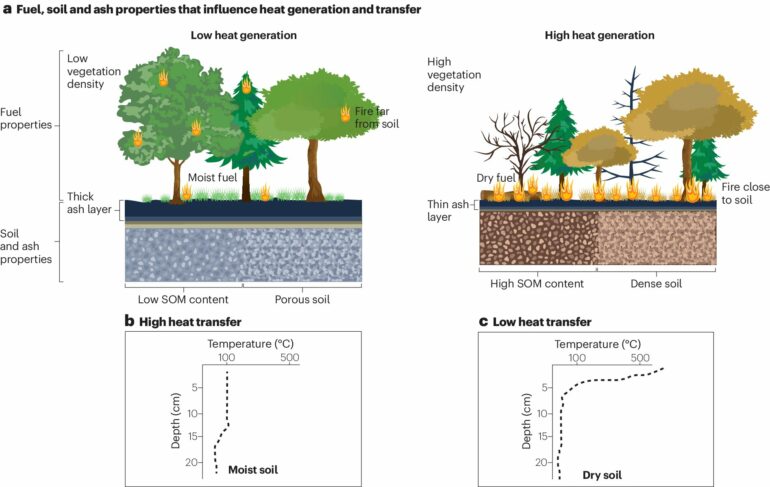The huge, long-lasting wildfires that have become increasingly common in recent years can cause changes in soil chemistry that affect water contamination, air quality, and plant growth. But these changes are poorly monitored and rarely factor into post-fire recovery efforts or risk assessments, according to a review study published May 14 in Nature Reviews Earth & Environment.
The study, led by Stanford University and Colorado State University scientists, found that better techniques are needed to monitor changes in soil and surrounding ecosystems. This enhanced monitoring could inform decisions on how to treat drinking water sourced from burned areas, support reforestation, and protect workers against toxins during cleanup, rebuilding, or revegetation.
“In our study, we mesh organic and inorganic chemistry together, whereas a lot of fire research will typically just consider one subject area,” said soil biogeochemist Claudia Avila, who co-led the study with Alandra Lopez, Ph.D. ’22, while both researchers were postdoctoral scholars in the lab of Stanford Doerr School of Sustainability Professor Scott Fendorf.
“A better understanding of the molecular mechanisms in soil can help explain, for instance, why drinking water from a forest fire-impacted watershed is suddenly more toxic, or why a forest is not coming back,” said Colorado State University soil chemist Thomas Borch, a senior author of the study.
Climate and ecosystem impacts
The review highlights evidence from recent studies suggesting wildfires may release more planet-warming carbon dioxide into the atmosphere than anticipated. Charcoal-like remnants of burned wood and other organic materials, known as black carbon, may not trap carbon dioxide for long periods, as scientists had hoped.
“Carbon that’s gone through forest fires and becomes black carbon can actually turn more readily into carbon dioxide by microbes than previously thought,” said Fendorf, the Terry Huffington Professor at Stanford.
“From a climate perspective, we still have a poor understanding of how much of the carbon that is left after a fire has the potential to be transformed into greenhouse gases, such as carbon dioxide,” said Borch, who worked in Fendorf’s lab as a postdoctoral fellow 20 years ago.
Wildfires can have many benefits for ecosystems, the authors note. Some fires can increase the nitrogen in soils and augment the water solubility of soil organic carbon, for example, setting the stage for regrowth. However, recovery depends on the presence of other chemicals. For instance, certain types of organic molecules formed in soil during fires are needed for many seeds to germinate.
If the local soil chemistry and fire conditions do not produce enough of these molecules, called karrikins, revegetation may be stunted.
Other research included in the new review has shown that wildfires can double the soil concentration of a group of toxic chemicals known as polycyclic aromatic hydrocarbons, which can induce chemical reactions that inhibit revegetation. These molecular-scale effects could well explain the mystery of vast areas where trees have struggled to reestablish after wildfires in the Rocky Mountains, Borch said.
Wildfires can also alter the chemical properties of inorganic materials such as metals within soils. Fire can change the metals into dangerous forms that readily move through the environment, ending up in the air or nearby water, the authors explained, citing Fendorf and Lopez’s own recent research.
The scientists documented high levels of a hazardous form of the metal chromium at wildfire sites resulting from heat-induced transformation of naturally occurring, benign forms of chromium. At sites where extremely hot, long-lasting fires cooked soils to high temperatures for extended periods, chromium persisted for many months until the next large rain event.
Other research on chromium indicates that after lower-intensity fires, remnant plant and animal tissue in soil can allow the toxic form of chromium to return to its inert form. Taken together, these studies illustrate the broader reality that wildfire impacts on soil chemistry depend on the intricate nature of the fire and landscape, including fire duration and temperature.
Predicting and mitigating wildfire risks
Broader surveillance and modeling could inform strategies for protecting lives, property, and natural resources, as well as wildlife management decisions. Avila offers an example of how this approach to informed stewardship could help prevent the leaching of metals into drinking water supplies.
“By identifying an area that has a high potential for, say, chromium release, we can call for prescribed burns that are lower intensity and reduce the potential for high-intensity, toxin-releasing fires,” said Avila, who is now an assistant professor of environmental and ocean sciences at the University of San Diego.
“If we can grasp the complexity of the intertwined processes that are happening both on the organic and the inorganic side, then that helps give us the ability to predict outcomes for different fire, landscape, and geological conditions,” said Fendorf.
More information:
Alandra Marie Lopez et al, Molecular insights and impacts of wildfire-induced soil chemical changes, Nature Reviews Earth & Environment (2024). DOI: 10.1038/s43017-024-00548-8
Provided by
Stanford University
Citation:
How wildfires change soil chemistry (2024, May 14)



